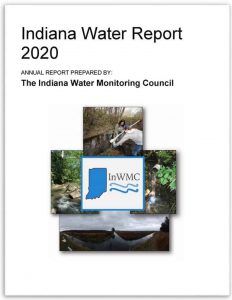In this country, we don’t think twice about the quality of our water. How many times a day do we use the faucet or a water source without giving a second thought to how clean our water may be? Despite the seamless flow of getting water from the source to our homes and businesses, there are many organizations working together behind the scenes to keep our drinking water safe and protect all our state’s water resources.
Since 2018, the Indiana Water Monitoring Council (InWMC) has published an annual Indiana Water Report to detail the current water monitoring efforts and research in the State of Indiana. In the 2020 report, 50 organizations contributed 67 project summaries taking place throughout the state. In our next post, we will look at some of the statewide initiatives, but first see what water monitoring and research happened in Marion County last year.
Activities in Marion County
For more details on these projects and others in Marion County that have statewide impacts, download the full 2020 Indiana Water Report.
Department of Earth Sciences at IUPUI
Students in IUPUI’s Principles of Hydrology class (GEOL-G430) have been working with Reconnecting to Our Waterways to study vegetation restoration on stream health in an urban setting. Soil quality, vegetation characteristics, and water quality are being sampled at 2 sites along Pogue’s run: Spade Park (which underwent vegetation restoration starting in 2016) and a control site near Harshman Middle School.
Both locations seemed to have an overall poor physical quality and some chemical parameters are similar between the two sites. However, some measurable improvements where shown in terms of site habitat, soil hydraulic conductivity, and trace metal pollution between Spade Park (the restored section of Pogue’s Run) and the control site. More frequent and longer term monitoring is needed to fully understand the impacts of restoration on urban stream health.
The impacts of urbanization on local water quality have been studied in different regions, but this is one of a few studies evaluating the impacts of vegetation restoration on stream health in an urban setting.
Marion County Public Health Department Monitoring
You may be familiar with the Marion County Public Health Department (MCPHD) if you are a business located in one of the county’s wellfields as part of your spill prevention and emergency response plans. Did you know that the MCPHD monitors the water quality in rivers, streams, and well-water from private residences throughout the Indianapolis area? Keep your eye out for the educational signs posted near some surface water sampling sites of areas of frequent recreation, public water intakes, or combined sever overflows. These surface water sampling data can be found back to 1995 on the MCPHD’s website: http://marionhealth.org/surface-water-program/.
MCPHD also does groundwater testing for bacterial and chemical contamination through the MCPHD’s Public Health Laboratory as part of neighborhood groundwater assessments, well permit processes, or individual requests from residents.
The Center for Earth and Environmental Science at IUPUI / USDA – NRCS / USGS
In 2020 monitoring efforts continued in the School Branch Watershed (located mostly in Hendricks county near Eagle Creek), to assess the chemical, physical, and biological impacts of conservation practices at the watershed, subwatershed, and edge-of-field scales. The project is a special collaborative effort of federal, state, local, and academic entities along with dedicated conservation minded farmers and includes continues monitoring of stream water, surface runoff, and subsurface flows plus other measurements of groundwater and biological indicators.
A particular area of focus this year was on Starkey Farms, which has a stream running through the property to Eagle Creek and has a watershed area of about 162 square miles. The reservoir and surrounding areas contribute much of the drinking water for the City of Indianapolis and help with flood control.
Since 2014, scientists have been assessing how conservation projects on this farm such as no-till, use of cover crops, micro-application of fertilizer and planting buffer strips are affecting the quality of the water as it enters the stream. In 2020, the Center in partnership with the USDA- National Resources Conservation Service and USGS installed an additional sampling site to sample surface and sub‐ surface water quality from a conventionally managed field near Starkey Farm. This new location will allow real‐ time comparison of both soil health and conventional tillage practices with water quality, stream health, and crop production.
Results of the overall School Branch project so far do show that agricultural productivity can be maintained while improving the water quality of surface and tile water from cropland by implementing soil health management systems. One more major step toward sustainable water resources in the Eastern Corn belt!
The White River Alliance’s RAFT Program
The White River Alliance (WRA) recently developed an advanced citizen science program, River Assessment Field Teams (RAFT), to strategically assess water quality in the Upper White River Watershed. This volunteer monitoring program collects high quality data to help fill agency data gaps, tease out pollution hot spots, and measure trends over time.
Volunteers will undergone training and use procedures approved by Indiana Department of Environmental Management (IDEM) and aligned with External Data Framework protocols, to collect at least monthly information about conductivity, dissolved oxygen (DO), nitrate, nitrite, orthophosphate, pH, temperature, transparency, flow, land use, riparian vegetation, stream shape, substrate, and E. coli. For more information visit the White River Alliance website.
Many thanks to the Indiana Water Monitoring Council for their great work in assembling the 2020 report! Read more about these water monitoring and research projects and others happening throughout the state in the full report.
Who is the Indiana Water Monitoring Council?
The Indiana Water Monitoring Council (InWMC) is a non-profit association founded in 2008 as a broad-based, state-wide body committed to enhancing the communication, collaboration and coordination of professionals, organizations, and individuals involved in monitoring Indiana’s water resources, including ground and surface waters, their physical, chemical and biological components, and associated wetland resources.

